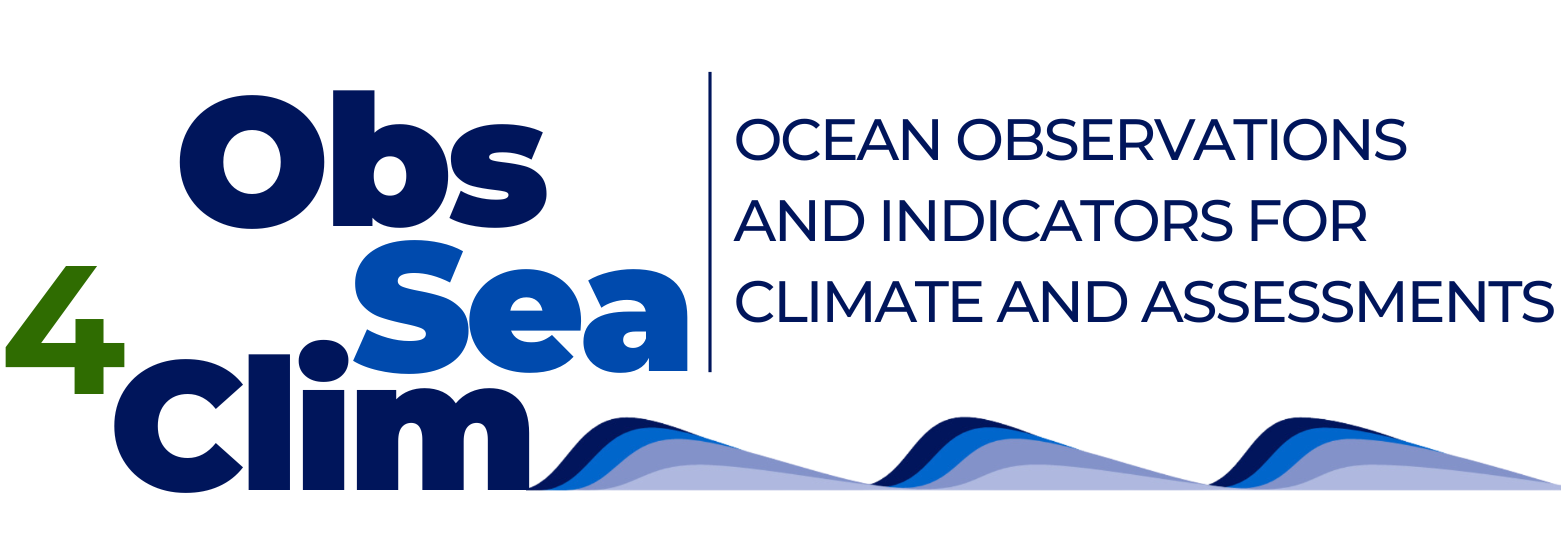Approach
Ocean climate observations, to be sustainable, must be an integral part of a multipurpose and integrated ocean observing system. Physical ocean climate observations are needed to deliver information and products to operational services (for instance, weather services, warning systems, etc.). The provided information is the baseline for drafting ocean state and climate assessments. To be able to deliver ocean forecasts and early warnings, climate projections and assessments and protect ocean health and its benefits, it is vital to measure Essential Ocean Variables (EOVs) and Essential Climate Variables (ECVs). These variables form the basis of the Global Climate Indicators that contain key information for the most relevant areas of climate change.
ObsSea4Clim aims at delivering an improved framework for sustainable ocean observation.
Our approach is based on the methodology developed by the World Meteorological Organisation, the Rolling Review of Requirements (WMO RRR). This WMO RRR system aims at integrating national observations to create a global system. At the heart of the system is a global set of data requirements for observations. This set has been generated from a synthesis of nations’ regional requirements. The requirements are validated against existing and emerging observing capabilities. A regular review of these requirements is need to check their adequacy.

ObsSea4Clim will implement the functioning of a sustainable and global ocean observation system for monitoring and predicting climate changes.
ObsSea4Clim will adopt four methodological steps (light blue boxes) and apply them to six application areas (in the center of the diagram).
Building blocks of ObsSea4Clim

Building block 1
ObsSea4Clim definition of the Essential Ocean Variables and Essential Climate Variables (EOV/ECV) Framework
ObsSea4Clim focuses on refining the current global EOV/ECVs framework to address regional and national climate information needs. This framework will be refined and integrated within the Global Ocean Observing System (GOOS) and the Global Climate Observing System (GCOS). In practice, this integration includes the following activities:
1) setting up a global integration,
2) establishing best practices and standards,
3) implementing an automatic quality control for recent and historical data,
4) aligning observational data to EOV/ECVs.
Once the integration is achieved, this will support climate assessments, projections, and actionable indicators useful for policymaking.
Building block 2
ObsSea4Clim definition of EOV/ECV-based Ocean Climate Indicators
ObsSea4Clim focuses on:
- the regionalization of indicators,
- the refinement of the indicator methods which are already in use,
- the application of the indicators to different time scales (short-term and long-term).
There is a strong need to work on the dissemination of these indicators to support sustainable ocean management. For this reason, ObsSea4Clim works in close contact with several representatives of ocean and climate initiatives (Stakeholder Reference Group) and with its sister projects, which have been funded under the same Horizon Europe call.
Building block 3
ObsSea4Clim six Application Areas
The ObsSea4Clim Application Areas are:
- Sea Level
- Ocean Transports
- Marine Heatwaves
- Ocean Mesoscale
- Ocean stratification
- Sea Ice.
Each application area is further subdivided into regional applications. The process will make use of:
- in-situ data (from aggregators e.g. EMODnet, CMS, nations and project-dedicated campaigns)
- satellite data (operational and experimental via ESA and global)
- ocean reanalysis model data (e.g. CMS reanalysis family).
These pilot activities will develop, test and improve the EOV/ECV framework.
Building block 4
ObsSea4Clim Improved projections and performance of Earth System Models
Earth System Models (ESMs) are key tools for projecting climate change and the risk of abrupt changes in the climate system:
ESMs provide support to policy, are tools for assessing risks, but also are powerful tools for elaborating mitigation and adaptation measures.
ObsSea4Clim will advance key physical ocean processes related to climate and time change by evaluating the performance of historical simulations and global and regional projections of CMIP6 ESMs. ObsSea4Clim will also support the development and improvement of the next generation of the ESMs (e.g., CMIP7) by improving the parameterization and tuning of the model parameters to reduce model biases in specific regions. These activities will also contribute to the implementation of the Lighthouses of the Horizon Mission “Restore Our Ocean and Waters by 2030“.
Building block 5
Making ObsSea4Clim science and innovation actionable
ObsSea4Clim will maximise impacts and promote multi-disciplinary ocean observing.
In this project, the teams will open a dialogue with similar project to ensure there is a strong exchange of knowledge.
- Clustering: A European EOV/ECV network will be set up to coordinate, exchange and align approaches across projects and initiatives.
- Making results actionable: Additionally, ObsSea4Clim will engage with a wide range of stakeholders to ensure the uptake of the project’s results
With the establishment of a forum for discussion and interaction, the Stakeholder Reference Group, ObsSea4Clim will engage experts from the scientific community and users of the project results.
